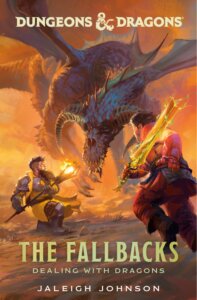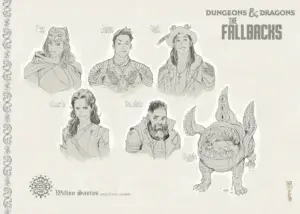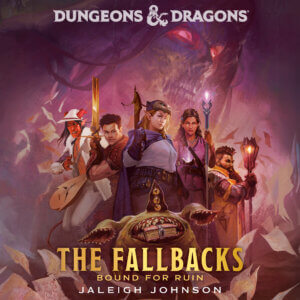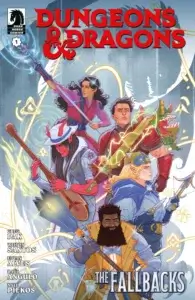I was really looking forward to the release of The Fallbacks: Dealing with Dragons, the second volume in the Fallbacks series by Jaleigh Johnson. The first book in the series, The Fallbacks: Bound for Ruin (read the review here), released in March 2024, brought back all the fun and excitement of the great era of the Forgotten  Realms novels from the late 1980s to the late 1990s. Starting with the release of R. A. Salvatore’s The Crystal Shard in 1988, fans were treated to several novel releases every year, each book being another great adventure set in the Forgotten Realms, arguably the most popular Dungeons & Dragons world setting. This was a golden age for D&D gamers who like a little fiction mixed in with their role playing.
Realms novels from the late 1980s to the late 1990s. Starting with the release of R. A. Salvatore’s The Crystal Shard in 1988, fans were treated to several novel releases every year, each book being another great adventure set in the Forgotten Realms, arguably the most popular Dungeons & Dragons world setting. This was a golden age for D&D gamers who like a little fiction mixed in with their role playing.
Return of the Forgotten Realms Novels
Following the sale of TSR, new D&D owner Wizards of the Coast (WotC) wound down its fiction department. That did not mean the total end of D&D novels, but gone were the days when fans could look forward to the release of several D&D novels within the same year.
WotC published other series and stand-alone novels over the years, including the Abyssal Plague and the Sundering series. There were also the occasional Drizzt Do’Urden trilogies by R. A. Salvatore, the Brimstone Angel series by Erin M. Evans and a few stand-alone novels (Spellstorm and Death Masks) by Ed Greenwood, creator of the Forgotten Realms.
Lately, fans have witnessed a renaissance of D&D novels. The releases are nowhere as frequent as they were during the great era. However, fans have been treated to the Dragonlance Destinies series (Dragons of Deceit, Dragons of Fate and Dragons of Eternity); the Generations series starring Drizzzt Do’Urden (Timeless, Boundless and Relentless) and the Way of the Drow series also starring Drizzt (Starlight Enclave, Glacier’s Edge and Lolth’s Warrior) by R. A. Salvatore; the new Ravenloft novel, Heir of Strahd (see the review here); the new Spelljammer novel, Memory’s Wake; and, of course, the first Fallbacks novel, Bound for Ruin. This fall also saw the release of a new R. A. Salvatore novel, The Finest Edge of Twilight, featuring Drizzt Do’Urden’s daughter, Brie. In short, it’s a good time to be a fan of D&D fiction.
Forgotten Realms Lore Deep Dive
In Dealing with Dragons, the story of the Fallbacks picks up pretty much where it left off at the end of Bound for Ruin. Jonhson wastes no time jumping into action, just like she did in Bound for Ruin. One of the things I like about Johnson’s D&D books is her respect for Forgotten Realms lore. The opening scene takes place in The Sunless Citadel. If you’ve been playing D&D long enough, chances are that some of your D&D characters cut their adventuring teeth in that dungeon. The Sunless Citadel is heralded as one of the all-time best D&D starter adventures. It was originally published in 2000 for 3rd edition D&D, and it was updated for 5th edition D&D in the Tales from the Yawning Portal anthology in 2017. It is considered one of the best introductions to D&D, not only for players, but for DMs as well.
takes place in The Sunless Citadel. If you’ve been playing D&D long enough, chances are that some of your D&D characters cut their adventuring teeth in that dungeon. The Sunless Citadel is heralded as one of the all-time best D&D starter adventures. It was originally published in 2000 for 3rd edition D&D, and it was updated for 5th edition D&D in the Tales from the Yawning Portal anthology in 2017. It is considered one of the best introductions to D&D, not only for players, but for DMs as well.
All the familiar elements of the Sunless Citadel are present in Dealing with Dragons: twig blights, the Gulthias Tree, the magical apple, etc. It’s a great blast from the past for OG fans that new readers and D&D players will also enjoy.
The book also features other staples of the Forgotten Realms. Some of the action takes place at the Host Tower of the Arcane, home of the Arcane Brotherhood, names that will be familiar to all Forgotten Realms fans. Readers are also treated to several classic D&D monsters.
Jonhson’s prose is highly evocative; she doesn’t need to steep the scenes in familiar Forgotten Realms tropes for the story to come to life. Still, readers who know the Forgotten Realms will feel a warm familiarity with the setting. If you’ve read many Forgotten Realms novels or played many D&D games set in that world, you almost feel as if you’re there, fighting twig blights along with the Fallbacks. It makes the story that much more engrossing.
The best Forgotten Realms adventures were always the ones that made you feel like you’re ridding down the Trade Way, exploring the ruins of Myth Drannor or having an ale at the Yawning Portal. It’s a great mix of the best elements of fiction and role playing games.
A Great New Villain
I don’t want to spoil the story, but it’s pretty obvious that the Big Bad is a dragon in this book. It’s refreshing to see a dragon appear as the main protagonist. While you’d expect Dungeons & Dragons to be replete with those magnificent beasts, historically, dragons have been noticeably scarce in the game. The Monster  Manual paints them as very powerful, and elder dragons (or greatwyrms) can aspire to godly status. They are highly intelligent, endowed with great physical strength, and capable of wielding spells as readily as the best wizards. In their second adventure, the Fallbacks face off against Ashardalon, a godlike greatwyrm.
Manual paints them as very powerful, and elder dragons (or greatwyrms) can aspire to godly status. They are highly intelligent, endowed with great physical strength, and capable of wielding spells as readily as the best wizards. In their second adventure, the Fallbacks face off against Ashardalon, a godlike greatwyrm.
The final confrontation between the Fallbacks and Ashardalon is nothing short of epic. No spoilers here, but it’s a great moment in D&D storytelling – not as earth-shattering or climactic as you would expect such a battle to be, but very satisfying nonetheless.
Antea is a formidable secondary villain who also gives the Fallbacks a hard time. Her unexpected final revelation makes her much more interesting than your average secondary character.
The Fallbacks as an Ensemble Cast
There is Tess, the female elf rogue, who is also the party leader; Anson, the male human fighter who wields a broken sword; Cazrin the female human wizard eager to learn more magic; Baldric, the male dwarf polytheistic priest; Lark, the male tiefling bard on the run from something; and, last but not least, Uggie, the pet Otyugh who turns out to be the most endearing character of the party. Uggie, once again, wins the prize for the weirdest and most endearing pet monster.
The Fallbacks share a lot with your typical D&D adventuring party, which makes them even more relatable to anyone who plays D&D. Reading their adventures, you can’t help yourself but picture them as characters played by people around a gaming table. In many ways, it feels like watching a streaming D&D game on YouTube, such as Acquisitions Incorporated or Critical Role, except that the prose makes the story and characters much more engaging than any video could ever do.
Baldric’s Polytheistic (and Dragon) Problem
The narrative revolves around Baldric’s problem hinted at in the previous book, the major villain plaguing the cleric. There are plenty of subplots going on at the same time, however. Baldric is not the only character being developed further. This is an ensemble cast, after all, and Johnson deploys great efforts to flesh out every single character (including Uggie, who just keeps on getting more endearing).
The dynamics of Baldric’s polytheistic approach to priesthood are explored further here. When I first encountered the idea while reading the previous adventure (Bound for Ruin), I thought it would be a great concept for a D&D cleric. The game mechanics escaped me, but in this second story, Johnson fleshes them out considerably, making Baldric’s approach to currying favors with the various gods of the Forgotten Realms feel more like “deal-making” than actually praying for spells. Baldric is very good at securing favors from the various gods of the Forgotten Realms. Johnson is very creative at finding ways for Baldric to convince the gods to help him. It’s an interesting concept in any fantasy setting, especially in a role playing game like D&D where priests, traditionally, follow only one god. It would make for some interesting role playing around the gaming table.
While Baldric’s issue with the Big Bad reaches a satisfying conclusion by the end of Dealing with Dragons, his conversation with the Aspect of Tyr (the god of justice in the Forgotten Realms’ pantheon) leaves no doubt that we haven’t read the last of Baldric’s relationships with the gods.
Character Development for the Other Fallbacks
Anson’s obsession with reconnecting with his brother causes serious friction within the group, exposing Lark to danger. Cazrin’s magical powers are key to exposing the evil at the root of Baldric’s problem. Tess has her hands full in this new adventure; she has to rein in some of her party members, resolve conflicts between some of them, and ensure they all derive some satisfaction out of being members of the group. All these subplots, conflicts and situations make for very interesting group dynamics. The party feels real, and you can’t help but be drawn in.
The characters were already pretty well fleshed out in Bound for Ruin, but Johnson dives even deeper into each character’s motivation and struggles in this new book. Character development doesn’t feel stretched out. The situations feel real and relatable. It’s hard to put the book down.
book. Character development doesn’t feel stretched out. The situations feel real and relatable. It’s hard to put the book down.
Other Fallbacks Stories to Tell
There is plenty of room left for more Fallbacks stories. In the last chapter of Dealing with Dragons, Tess is warned by her mentor, the halfling Mel; the Fallbacks attracted a lot of attention during their latest adventure. They have become known to the Harpers and the Arcane Brotherhood – those are not nefarious organizations, but Mel hints at what might come next. Lark’s story arc still remains to be explored. And I absolutely haven’t had enough of Uggie.
I don’t know how many books Johnson and WotC plan to publish in the Fallbacks series, but I like to think we will be treated to at least a few more novels.
October also saw the release of the new Fallbacks comic book by Dark Horse. The series will tell other stories of the Fallbacks. I haven’t read it yet, but Dungeons & Dragons has had a long, fruitful and satisfying relationship with comic books going all the way back to the original Advanced Dungeons & Dragons and Forgotten Realms comic book series put out by DC in the late 1980s and early 1990s. I can’t wait to see if this new series will live up not only to its predecessor comic books, but also to the Fallbacks novels.
